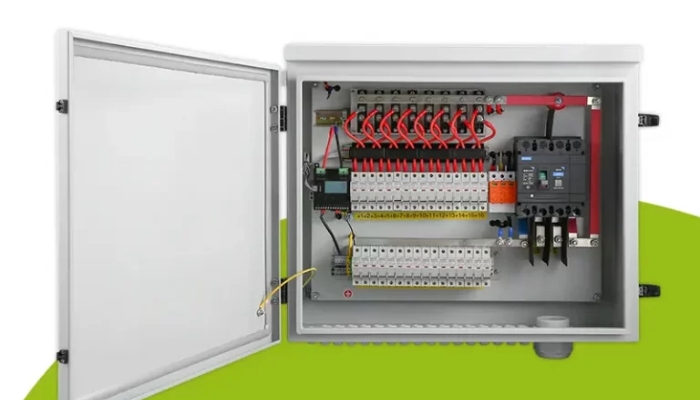A solar combiner box, also known as a combiner box, is a key component in a photovoltaic system. It is used to bring together the output current of multiple solar panels in series and deliver it to the inverter. Many people know that a combiner box allows a photovoltaic system to operate more efficiently and safely, but many people don’t know how to size a solar combiner box for their needs or applications.
To choose the right combiner box, you just need to know a few basics: how many strings you have, the current and voltage they produce, and a few other key details. In this guide, we’ll walk you through everything you need to consider so that you can choose the perfect combiner box for your solar installation and keep your system running smoothly.

Determine the number of solar strings
You need to determine how many solar strings your system has. For example, if you have 20 solar panels and configure them into 4 strings with 5 panels each, then you will need a combiner box that can accommodate at least 4 strings. This ensures that each string has a dedicated input into the combiner box.
Calculate the maximum current rating
Each solar string draws a certain amount of current (measured in amps). To properly size the combiner box, first calculate the maximum current for each string and then multiply by 1.25 to allow for a safety margin in compliance with the NEC. This will determine the minimum fuse or circuit breaker rating required for each string. Make sure the total current for all strings does not exceed the maximum rating of the combiner box.
For example, if each string draws 9 amps, multiplying by 1.25 gives a required rating of 11.25 amps, so the fuse or circuit breaker should be at least 12 amps. If the combiner box supports 10 strings, each drawing 10 amps, the total current rating of the combiner box should be at least 100 amps (10 strings x 10 amps).
Choose the right voltage rating
The voltage rating of the combiner box should equal or exceed the maximum system voltage, which is usually determined by the open circuit voltage (Voc) of each solar panel multiplied by the number of panels in series. Common combiner box ratings include 600V, 1000V, or 1500V. Make sure the combiner box you choose can handle the voltage of your PV system.
For example, if the open circuit voltage of each panel is 40V, and each string has 10 panels, the total voltage of each string is 400V. If you expect that cold weather may cause the system voltage to increase, then choosing a combiner box with a voltage rating of 600V can better handle potential voltage fluctuations.
Choose the right number and type of fuse holders or circuit breakers

Each string in the system requires overcurrent protection, typically provided by fuses or circuit breakers in a combiner box. Choose a combiner box that can accommodate the number of fuse holders or circuit breakers appropriate for your strings. Also, make sure the fuse holders or circuit breakers are rated for the voltage and current of your strings.
If you have 5 strings, you will need a combiner box that can accommodate 5 fuses or circuit breakers. Each fuse or circuit breaker should match the voltage and current rating calculated previously. A practical practice is to use a combiner box with fuse holders rated for 600V and up to 15A per string.
Consider environmental conditions
Solar combiner boxes are often installed outdoors, where they are exposed to salt water and strong sunlight, so choose a combiner box with a NEMA 4X or IP65 rating. These ratings ensure that the combiner box is waterproof and corrosion-resistant, providing durability in harsh outdoor conditions.
Evaluate the need for monitoring capabilities
Modern solar systems often include monitoring capabilities to track the performance of individual strings or the entire system. If you need real-time performance data, choose a combiner box with integrated monitoring capabilities.
Some combiner boxes allow you to remotely monitor the output of each string, which is very useful for troubleshooting. For commercial solar farms, having such a feature can quickly identify and resolve problems such as shading or panel degradation, preventing serious power losses.
Evaluate Expansion Possibilities
Consider whether you will expand your solar array in the future. If so, choose a combiner box with more input slots than you currently need to accommodate more strings later.
Let’s say you currently have 8 strings but plan to add 4 more in the future. Rather than replacing the combiner box later, choose one with at least 12 inputs now. This way, you can easily connect additional strings as your system expands, saving time and money.
Verify compliance with local electrical codes
Make sure the combiner box you choose complies with local and national electrical codes, such as the NEC in the United States or IEC standards in Europe. This includes making sure the combiner box is certified by the relevant agency (such as UL in the United States) and meets the requirements for grounding, overcurrent protection, and labeling.
Plan for a safe and convenient installation
The combiner box should be installed in a location that allows for safe and easy installation, maintenance, and inspection. The combiner box should be installed where it will not be physically damaged and is easily accessible to technicians. Make sure the combiner box is installed according to the manufacturer’s recommendations and local electrical codes.
Budget considerations

Finally, balance your choices against your budget. Higher-rated combiner boxes with advanced features like integrated monitoring or higher IP/NEMA ratings may be more expensive, but they offer long-term advantages in terms of system reliability, safety, and scalability.
If you are working on a residential project with a limited budget, you may be able to opt for a basic combiner box without advanced monitoring. However, for commercial installations, investing in a more expensive combiner box with advanced features like remote monitoring and high voltage ratings can save money in the long run by reducing downtime and maintenance costs.
MOREDAY is at your service

MOREDAY’s combiner boxes not only support the access of multiple strings, ensuring the safe and efficient operation of the system under various conditions; these combiner boxes also provide overcurrent protection and system monitoring to help users understand the performance of the system in real-time.
They are designed with the use requirements of harsh environments in mind, have high weather resistance and easy installation, and are very suitable for various solar application scenarios.
If you are looking for a high-quality combiner box that can improve system reliability and safety, MOREDAY is a trustworthy choice. They offer different types of combiner boxes, click to contact us to get an accurate quote! Let MOREDAY combiner boxes escort your photovoltaic system!
Related reading: What is a Combiner Box?


